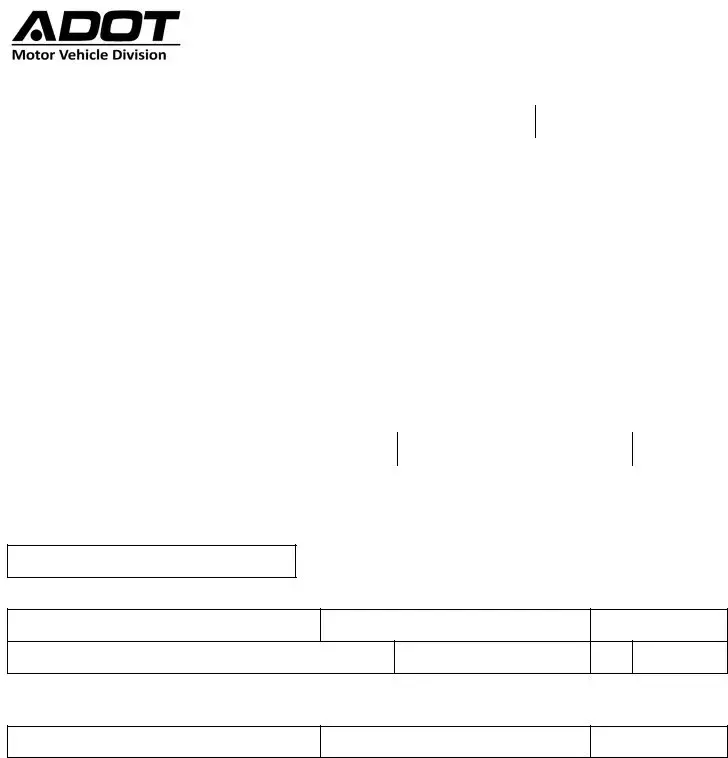The Vehicle Title Application is closely related to the Arizona Repossession Affidavit in the sense that it also involves the formal identification of a vehicle, including details like the Vehicle Identification Number (VIN), make, year, and the registered owner's name. Both documents serve crucial roles in the vehicle ownership transfer process, acknowledging specific details about the vehicle in question and identifying those who have legal rights or interest in it. The key difference lies in their purposes: while the Repossession Affidavit is used to confirm the transfer of ownership due to default on payments, the Title Application is used to establish ownership in a more general context.
Another document that shares similarities with the Arizona Repossession Affidavit is the Mechanic's Lien. This legal form is used when a service provider (like an auto mechanic) has not been compensated for labor or materials. Similar to the Repossession Affidavit, a Mechanic's Lien asserts the claimant's legal claim over the property (in this case, a vehicle) due to payment default. Both documents are predicated on the principle of protecting financial interests and ensuring remuneration for provided services or loans, and they both must be filed correctly to be enforceable.
The Bill of Sale part of the Repossession Affidavit mirrors a standalone Bill of Sale document, which serves as a receipt for the transaction between a buyer and a seller. It includes essential information such as the vehicle's description, the sale date, and both parties' names and addresses. The primary purpose of both documents is to evidence the transfer of property; however, the Bill of Sale in the Repossession Affidavit also signifies the end of the repossession process by finalizing the change of ownership.
The Odometer Disclosure Statement is another form that shares similarities with this affidavit, specifically in the section requiring odometer readings. It is a crucial document for ensuring transparency in vehicle transactions, verifying the mileage of a vehicle at the time of sale. While the Repossession Affidavit incorporates this as part of its broader function, the standalone Odometer Disclosure Statement is focused solely on preventing odometer tampering and ensuring that buyers are aware of the vehicle’s mileage.
Similarly, the Notice of Default and Intent to Sell can be compared to the Repossession Affidavit. This notice is often required to be sent to the defaulting party before a vehicle can be legally repossessed. It outlines the details of the default and provides a final opportunity for the debtor to remedy the situation. Both the notice and the affidavit are parts of the repositional process, but the affidavit acts as the conclusive document, officially transferring ownership post-repossession.
Another related document is the Security Agreement that outlines the terms under which a lien is placed on a vehicle. This document parallels the Repossession Affidavit as it establishes the lienholder's rights to repossess the vehicle in the event of default. Both documents are integral to ensuring that the lienholder can enforce their security interest in the vehicle, but the affidavit is specifically used to formalize the repossession that occurs after a default.
The Release of Lien is yet another related document, which is used when a loan on a vehicle is fully repaid, and the lienholder releases their interest in the vehicle. This process is reverse to that of the Repossession Affidavit, which is used when a borrower defaults on a loan. While the affidavit transfers ownership due to a default, the Release of Lien certifies that the vehicle is free from liens due to the fulfillment of the financial obligation.
The Power of Attorney for vehicles is a form that allows an individual to appoint someone else to act on their behalf in matters related to a vehicle, such as registration or sale. This document is similar to the Repossession Affidavit in that it involves legal authorization regarding decisions about a vehicle. However, while the Power of Attorney grants someone the authority to make decisions, the affidavit is used to document a specific action taken – in this case, the repossession.
Finally, the Judgment of Repossession from a court, which authorizes a lienholder to proceed with the repossession of a vehicle, shares objectives with the Repossession Affidavit. Both documents legally facilitate the transfer of ownership due to default. The distinction between them lies in their origins; the judgment is an order issued by a court, whereas the affidavit is a statement made by the lienholder to declare that repossession has taken place.
